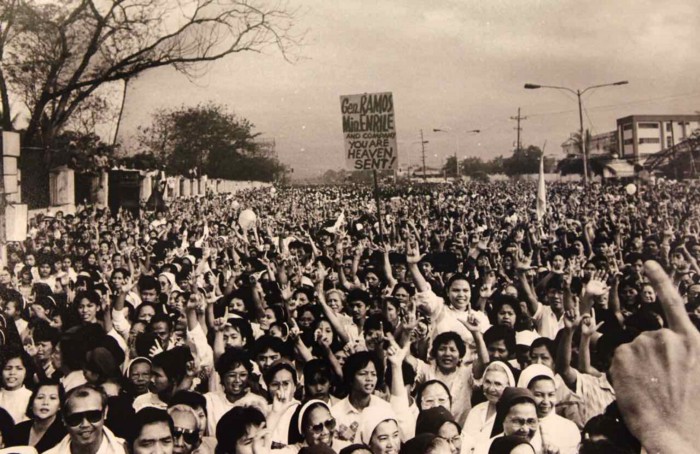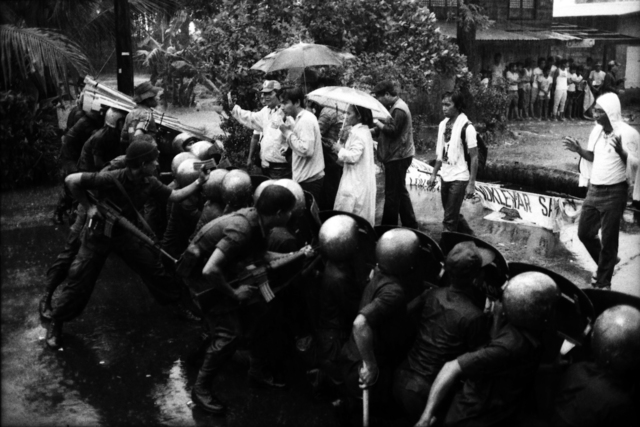
Years have passed, and the wounds of the past are healed. Democracy hates dictatorship, thus Filipino people fought for their freedom during the 1986 People Power Revolution. The peaceful demonstration captivated the world and served as a beacon of hope for every Filipino that fought for freedom and democracy. The EDSA People Power Revolution remains a pivotal part of Philippine history, marking the victory of the Filipino people against the dictatorship and oppression. In this article, we will know a short summary of the history of the EDSA Revolution, where we will explore the events that led up to the revolution and the role of the Filipino people in shaping its outcome.
In addition, we also aim to shed the light on the remarkable resilience of the Filipino people, which led to historical facts that we will find nostalgic and interesting facts about the EDSA Revolution.
What is the People Power Revolution and Why is it Important?
President Ferdinand Marcos declared martial law to be in effect throughout the entire Philippines on the evening of September 23, 1972, which lasted until 1981. During this period, the government was characterized by authoritarian rule, human rights violations, killings, censorship, suppression of political opposition, and mainly the abuse of power by the Marcos regime. Marcos used the military and police to maintain control and silence his critics, leading too much abuse and corruption. Under the dictatorship, thousands of Filipino people went missing and were arrested, imprisoned, and tortured, especially when they opposed the government. The economy at that time also suffered with large amounts of public funds being corrupted by Marcos and his cronies. However, during the 1986 elections, Cory Aquino, the widow of the assassinated Ninoy Aquino, got a petition with more than a million signatures urging her to run against Marcos just two months after an organization was formed to push for her presidency.

Image from the Central Philippine University
February 1986 was the start of the momentous downfall of the Marcos regime. From February 22 to 25, millions of Filipino people gathered along the Epifanio de los Santos Avenue, or EDSA in Metro Manila and in many other cities in the country to show courage and stoop up to overthrow the dictatorial regime of Ferdinand Marcos. During the four days of the People Power Revolution, a lot happened—the turning back of many Marcos allies to support the Filipino people; students, priests, and nuns gathered to start a prayer vigil; average citizens of the Philippines joined forces to stand up against dictatorship; and armies, tanks, and police were present as well at first to defend Marcos, but also turned back to join the revolution against him. Around 10 in the evening, Marcos, together with his family and other cronies, fled the country which saw the stepping down of the president and signified the victory of the entire Filipino people who fought for the peaceful revolution. The EDSA People Power Revolution is important as this was declared the rebirth of the Philippines' democracy after the 20-year rule of Ferdinand Marcos ended.
EDSA @ 37: 6 Facts Everyone Should Know About the People Power Revolution
To further uncover the historical facts after 37 years, here are 6 interesting facts about the People Power Revolution that everyone should know:
The Media Played a Major Role in the Revolt
The media, particularly the radio, was used as a tool by the opposition to communicate with the public and rally them to join the peaceful protests. The coverage of the events of the EDSA Revolution by Radio Veritas at that time helped galvanize support for the revolution and the downfall of the dictatorship. On February 22, around nine o’clock in the evening, a message was aired through radio station Radio Veritas, a Roman Catholic radio station owned and run by the Archdiocese of Manila. Cardinal Sin advised Filipinos to go to EDSA, the section between Camp Crame and Aguinaldo. People took to the streets and took part in the revolution despite their hesitation. Radio Veritas was a crucial medium of communication for the people on the 4-day strike. Through the radio, they are broadcasting to people about the government’s actions and disseminated goods like food and medicines which made government troops target the station and took down their 50-kilowatt main transmitter. What happened brought dismay to people who were tuning in to Radio Veritas. Though reporters returned as Radio Bandido and moved to another undercover location and remained broadcasting for the rest of the revolution.
The Revolution Lasted for Four Days
Millions of Filipino people gathered from different walks of life along the Epifanio de Los Santos Avenue in Manila on February 22-25, 1986. The peaceful political uprising lasted for four days. Juan Ponce Enrile, the defense minister, learned about a plan to expose him and members of the Reform the Armed Forces Movement. This caused Enrile and his allies to turn their backs on the dictator. The military ultimately withdrew its support for Marcis and declared its allegiance to Corazon “Cory” Aquino. On the night of February 22, hundreds of Filipino people took to the streets to protest and show their support for the opposition leader, for the demand for change. Priests and nuns also gathered and held a mass vigil that evening. In the next following days, the number of people multiplied.

Image from Rappler
Filipinos prayed and walked together along the EDSA. On February 25, around 10 o’clock in the evening, Marcos and his family and other allies fled the country and Aquino was sworn in as the new president and marking the stepping down of the former president at the time.
Radio Veritas was the Sole Radio Station that Covered the Revolution

Image from CNN Philippines
Radio Veritas was the only radio station that bravely broadcasted the EDSA Revolution events that government-owned stations failed to do. Radio Veritas was passionate about relaying the truth, which favors the name Veritas, which means truth in Latin. The Radio Veritas was owned by the Catholic church and was run by Cardinal Sin, who was the voice behind the encouragement and the call for a peaceful revolution.
The L-Shaped Hand Sign
The L-shaped hand sign was a gesture made by raising both index and thumb while the pinky, middle, and ring fingers are folded, creating the shape of the letter “L”. This symbol was used to represent “Laban” or the fight against the Marcos regime. This also shows solidarity among protesters. However, the L hand sign interchangeably uses for LABAN Party which was founded by then-Senator Ninoy Aquino. Still, the hand gesture became an iconic symbol for the EDSA People Power Revolution and is still remembered as a symbol of hope, peace, and democracy during the People Power Revolution.
The Significance of the Yellow Ribbon
The yellow ribbon was used to represent hope, unity, and the collective desire for change among the protesters. A yellow ribbon was tied around people’s arms, trees, and cars. The 1973 song “Tie a Yellow Ribbon Round the Ole Oak Tree” by the American band Dawn inspired the revolutionary yellow at the time. The song describes a war prisoner begging his love to tie a yellow ribbon around an “old oak tree” to tell if he is still welcome to return to her life. He then returns and finds a tree full of yellow ribbon. This contradicts what happened to Ninoy, who was assassinated before he come home because he never got to see how many fans had welcomed him with lots of yellow ribbons tied. The yellow ribbon served as a visible sign of the People Power Revolution.
Bayan Ko and Magkaisa Were Iconic Songs at the Time
“Bayan Ko (My Country)” and “Magkaisa (Unite)” were both an EDSA Song. Bayan Ko and Magkaisa are considered iconic songs during the People Power Revolution. They were used as anthems of the movement and became of the struggle for democracy and freedom. Bayan Ko originally composed a Spanish poem “Nuestria Patria” in 1898 zarzuela Walang Sugat (No Wound) by Severino Reyes. It was then translated into Tagalog by Jose Corazon de Jesus designed in 1928 in opposition to the American occupation. On the other hand, Magkaisa was composed by Vicente “Tito” Sotto. It was originally sung by Virna Lisa Loberiza. It was also sung during the funeral of the first Filipino female president and Ninoy’s wife, Cory Aquino.
Should the EDSA Revolution Still be Honored Today?
Whether the EDSA People Power Revolution should still be honored today is a matter of personal opinion and can depend on various views, such as personal or ancestral experiences, political views, and understanding of the events that took place. However, the EDSA Revolution was a pivotal moment in Philippine history and marked the restoration of democracy and peace that we still have up until now. It must be commemorated for the lost lives and affected families—during the Marcos regime, the people who sacrificed, and a nation that unites during that time. In the end, it is up to each individual to make their own decision about whether the EDSA Revolution should be commemorated based on their own perspective, upbringing, and values.

Image from Rappler
After 37 years, the EDSA People Power Revolution serves as a reminder of the power of peaceful protest and the ability of ordinary Filipino citizens to change the nation. The hardship, hesitations, symbols, songs, and nostalgic stories of the EDSA Revolution may continue to inspire the Filipino people to bring change—to stand up and fight for their rights. Now that another Marcos is in the seat, may this country look back and remember the important lessons of EDSA. The revolution was a positive step forward, however; it has not brought about all the changes that were promised, and more needs to be done to address ongoing issues in the country.
The EDSA Revolution is considered to be a turning point in Philippine history and we hope that this coming February 25, we commemorate the reason for the people-led revolution by our ancestors, Lolos and Lolas.




